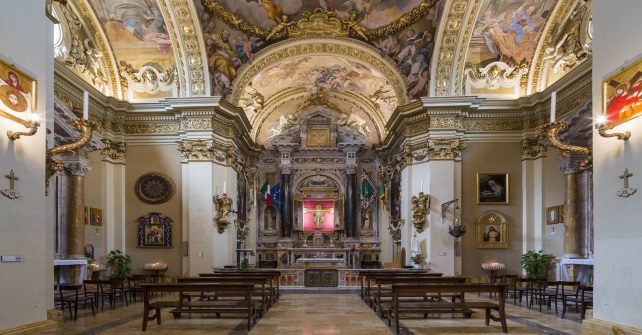






The Sanctuary-House of Saint Catherine is today a unified architectural complex which perfectly integrates into the urban fabric of Siena. It lies, tucked away, along the slope that leads from the church of San Domenico (itself an important site for the cult of St Catherine), down towards Fontebranda (one of the ancient fountains that supplied water to the medieval city). In reality, the various parts of the complex are the result of successive waves of construction over the centuries. It is likely that the first nucleus of the presumed house of the saint dates back to at least 1343, as a rent contract survives, indicating that in this year a house and dyer's workshop were rented to St Catherine's father, Jacopo Benincasa. Catherine herself was probably born on the 25th of March 1347 in Siena and passed away in Rome on the 29th April 1380. After her death, the Sienese were only able to retrieve her head, which rests in San Domenico to this day. St Catherine was much venerated in Siena and in Italy at large by the time of her deth, and from 1424 on, the parishes of Sant'Antonio and San Pellegrino, which later united to form the contrada of the Goose, became interested in constructing a shrine for the cult worship of the saint. Thus an architectural complex grew up around the buildings presumed to have been her childhood home in the wake of her canonisation in 1461 by Pope Pio II Piccolomini (himself Sienese). Like a treasure chest, the complex guards gems of medieval, renaissance and baroque art, along with some relics of St Catherine. Entering the sanctuary through its current entrance at the 'Portico dei Comuni'(1941), we find the dining hall, known as the 'Oratorio della Cucina', on the left. This space was constructed in the late 1500s for the Lay Fraternity of St Catherine in what was thought to originally have been the kitchen. Its walls are adorned with works illustrating scenes from the saint's life by famous artists of the time, such as Riccio and Francesco Vanni. To the right on entering is the Church of the Crucifix. This masterpiece of Baroque art was built between 1611 and 1623 to house the precious crucifix from the 12th century which allegedly brought on St Catherine's stigmata in 1375. The Church of the Crucifix and the 'Oratorio della Cucina' are connected by a beautiful renaissance portico which has always been attributed to Baldassare Peruzzi, despite the fact that he had already been dead for over a century at the time of its construction. Also on the ground floor of the sanctuary is the 'Oratorio della Camera e della Cameretta'; The 'Camera' was allegedly St Catherine's bedroom and it housed the famous crucifix from 1565 to 1623. Its frescoes date from 1873, the year of its restoration, while the small adjacent room, 'La Cameretta', has remained untouched. To this day it still contains the stone cushion upon which Catherine slept, along with some other relics.
Storia
Storia
Storia
Storia
Storia
Storia
